OUR OQEANOUS STUDENTS
- HOME
- OUR OQEANOUS STUDENTS
- IJP
- IJP Report (KMOU Mar - July 2023)
International Joint Program
IJP Report (KMOU Mar - July 2023)
2023.10.20
Graduate School of Marine Science and Technology
Course of Shipping Logistics Major
First Year of Master's Program
T. T.
From March 2, 2023 to July 10, 2023, I had studied at KMOU in Korea. I aim for this report to shed light on university life in Korea and serve as a comprehensive guide for prospective students.
[Why KMOU?]
Three things led me to choose KMOU in Korea. The first is the place. Korean shipbuilding is well-known. The Busan Port is one of the busiest ports in the world. I thought this setting would be excellent for my future work in both research and academia. The second is my background in research. Our lab has many students from several countries. This attracted my interest in international study. Additionally, one KMOU student in our TUMSAT's lab had already received a degree from there, which gave me greater confidence in my choice. In the third, my major. Our department combines ship navigation with logistics. I work in ship navigation and am interested in logistics. So, I went with the lab at KMOU that was dedicated to logistics.
[ First steps in Korea]
These are a summary of my language level before I depart to Korea.
English: I practiced speaking English in Japan. Simple chats were okay, but explaining complicated things were a bit tricky. I addressed this by engaging in online lessons and joining international meetup events in Tokyo.
Korean: I had only learned little Korean for a month before coming to there, Reading Hangul is good, but I basically simply know how to say "hello" and "thank you."
When I reached Korea, the COVID-19 situation had improved. This was great because I could go to class and travel without problems.
[Living at KMOU]
Location: KMOU is located at the southern tip of Busan (so close to Japan that Tsushima is visible on clear days). It takes about 40min to city area by bus.
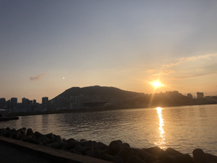
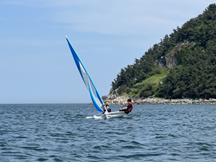
Photo1) Photos in KMOU; Left: sunset view; Right: Joining yacht club;
[Dining]
University Cafeteria: A fusion of spicy and salty flavors characterizes most meals. Apart from the prepaid semester meal plans, various eateries offer other options such as hamburger, ramen and etc. costing around 500 yen.
Dining Out: For those averse to spicy food, options like Seolleongtang and Samgyetang are available. Additionally, Korean restaurants serves multiple free side dishes. Of course, there are a variety of additional choices, including fast food and Japanese restaurants.
[Shopping]
The campus houses a convenience store, while a supermarket is merely a 15-minute walk away. For those familiar with Daiso, a bus ride of 10 minutes will get you there. The famous Nampo-dong area, reachable in 40 minutes by bus, is known for its affordable shopping options and malls. Especially in tourist-centric regions like Nampo-dong, many have a rudimentary understanding of Japanese and English.
[Research]
Lab: The lab specializes in Logistics and is overseen by a professor who received his PhD in Japan. He also taught me Korean in Japanese as well. The lab has diversity of settings, almost half of students from Vietnam. Regular activities like department parties, seminars, picnics, and hiking trips foster friendship. I had joined the seminar in our lab in Gaeje-do, the trip to Ulleung-do for two nights and three days, and the conference in Vietnam with the trip in August thanks to the support of my professors. Great experiences and enduring memories were had.
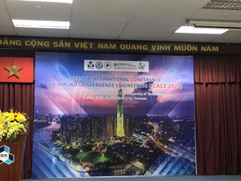
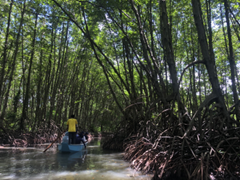
Photo2) Photos in Vietnam(Ho chi min city); Left: Conference in Ho chi min city University of Technology; Right: Field trip in Can Gio
Topic: I worked on controlling pitch-roll amplitudes in ships in KMOU. This involved delving into computer simulations, programming, and intensive paper readings. The subject will be the focus of my graduate thesis.
Class: I took two courses in KMOU. "Reliability Engineering" (taught in English, involving lectures, Discussions, and PowerPoint presentation) and "Basic Korean I", which significantly improved my Korean language skills. It wasn't too difficult to follow up. Frist one was useful to process for supply chain and system development.
Note: Beginning with the fall semester, you might take "Basic Korean II" instead of "I" in your Korean class.
As an exchange student: You will frequently interact with other international students from Northeast and Southeast Asia. Field trips and other cultural experiences will enhance these interactions. On the field trip, we went to Ulsan, Geoje-do, and Gyeongju (an ancient capital with a rich history). A "Buddy Program" has been put in place to match welcoming local students with newcomers, ensuring seamless cultural insertion. In my situation, I occasionally joined the yacht club where my buddy is a member.
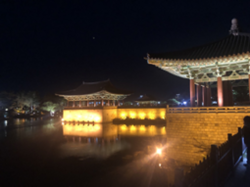
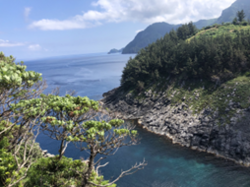
Photo3) Photos in Korea by trip; Left: Donggung Palace (Gyeongju); Right: Ulleung-do
[Life in Korea]
Transportation: The T-money card serves as Korea's counterpart to Japan's Suica card, making travel hassle-free. With the punctuality of trains and buses, commutation is smooth. It's worth noting that Google Maps isn't optimal for transit in Korea; local alternatives like Kakao Map or Naver Map are more reliable.
Banking and Visa: Payment in Korea is almost credit card, even in local eateries. The university's administrative department aids in necessary procedures upon arrival. However, for functionalities like mobile payments and debit cards, a student visa becomes essential. My student visa was granted three months after I applied.
Language: Main language is Korean. Some places English is available like Japan. Korean linguistic roots trace back to Chinese characters, which facilitates the understanding of Japanese to an extent. High school students learned Japanese or Chinese as second foreign language because of understanding about Chinese characters, so some students have a basic grasp of Japanese, which encourages language exchange. Over time, my competence has evolved from basic reading skills to describing straightforward situations, largely thanks to conversational sessions with local friends.
Communication: KakaoTalk reigns supreme as the principal communication tool, used for everything from academic discussions to casual banter. Kakaopay facilitates daily transactions.
[Post KMOU Experience]
Concluding this program was undeniably my most formidable challenge yet. The unwavering support from my professor, lab mates, coordinators, and friends was instrumental. My stint abroad had its fair share of challenges, but the consistent assistance and the innate kindness of the Koreans made it memorable.
For those contemplating studying abroad, I hope this report offers both insights and inspiration!

